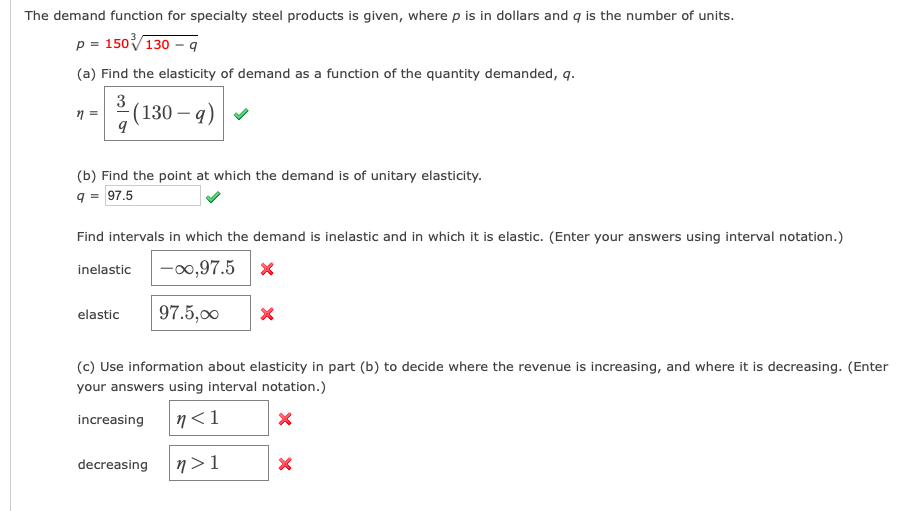The demand function for specialty steel products is given, where p is in dollars and q is the number of units. p = 150130 – 9 (a) Find the elasticity of demand as a function of the quantity demanded, q. (130 – 4) - (b) Find the point at which the demand is of unitary elasticity. q = 97.5 Find intervals in which the demand is inelastic and in which it is elastic. (Enter your answers using interval notation.) -00,97.5 x inelastic elastic 97.5,00 (c) Use information about elasticity in part (b) to decide where the revenue is increasing, and where it is decreasing. (Enter your answers using interval notation.) increasing n<1 decreasing n >1
The demand function for specialty steel products is given, where p is in dollars and q is the number of units. p = 150130 – 9 (a) Find the elasticity of demand as a function of the quantity demanded, q. (130 – 4) - (b) Find the point at which the demand is of unitary elasticity. q = 97.5 Find intervals in which the demand is inelastic and in which it is elastic. (Enter your answers using interval notation.) -00,97.5 x inelastic elastic 97.5,00 (c) Use information about elasticity in part (b) to decide where the revenue is increasing, and where it is decreasing. (Enter your answers using interval notation.) increasing n<1 decreasing n >1
Classical Dynamics of Particles and Systems
5th Edition
ISBN:9780534408961
Author:Stephen T. Thornton, Jerry B. Marion
Publisher:Stephen T. Thornton, Jerry B. Marion
Chapter11: Dynamics Of Rigid Bodies
Section: Chapter Questions
Problem 11.8P
Topic Video
Question

Transcribed Image Text:The demand function for specialty steel products is given, where p is in dollars and q is the number of units.
p = 150V130 – q
(a) Find the elasticity of demand as a function of the quantity demanded, q.
n =
(130 – q)
(b) Find the point at which the demand is of unitary elasticity.
q = 97.5
Find intervals in which the demand is inelastic and in which it is elastic. (Enter your answers using interval notation.)
|-00,97.5 x
inelastic
elastic
97.5,00
(c) Use information about elasticity in part (b) to decide where the revenue is increasing, and where it is decreasing. (Enter
your answers using interval notation.)
increasing
n<1
decreasing
n > 1
Expert Solution
This question has been solved!
Explore an expertly crafted, step-by-step solution for a thorough understanding of key concepts.
Step by step
Solved in 3 steps with 3 images

Knowledge Booster
Learn more about
Need a deep-dive on the concept behind this application? Look no further. Learn more about this topic, physics and related others by exploring similar questions and additional content below.Recommended textbooks for you

Classical Dynamics of Particles and Systems
Physics
ISBN:
9780534408961
Author:
Stephen T. Thornton, Jerry B. Marion
Publisher:
Cengage Learning

University Physics Volume 1
Physics
ISBN:
9781938168277
Author:
William Moebs, Samuel J. Ling, Jeff Sanny
Publisher:
OpenStax - Rice University

Classical Dynamics of Particles and Systems
Physics
ISBN:
9780534408961
Author:
Stephen T. Thornton, Jerry B. Marion
Publisher:
Cengage Learning

University Physics Volume 1
Physics
ISBN:
9781938168277
Author:
William Moebs, Samuel J. Ling, Jeff Sanny
Publisher:
OpenStax - Rice University